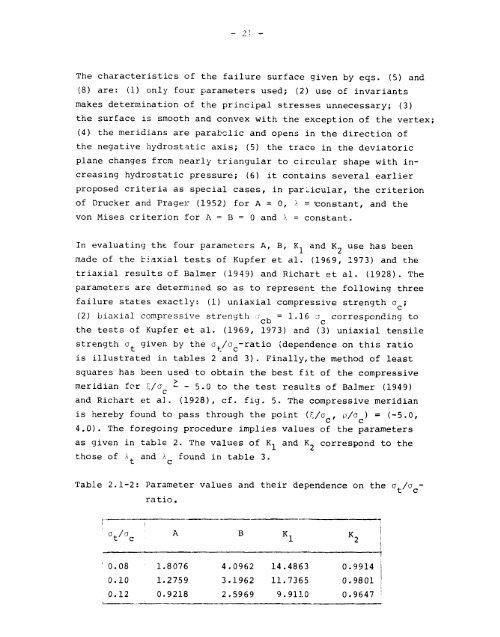Nonlinear Finite Element Analysis of Concrete Structures
Nonlinear Finite Element Analysis of Concrete Structures
Nonlinear Finite Element Analysis of Concrete Structures
Create successful ePaper yourself
Turn your PDF publications into a flip-book with our unique Google optimized e-Paper software.
The characteristics <strong>of</strong> the failure surface given by eqs. (5) and<br />
(8) are: (1) only four parameters used; (2) use <strong>of</strong> invariants<br />
makes determination <strong>of</strong> the principal stresses unnecessary; (3)<br />
the surface is smooth and convex with the exception <strong>of</strong> the vertex;<br />
(4) the meridians are parabolic and opens in the direction <strong>of</strong><br />
the negative hydrostatic axis; (5) the trace in the deviatoric<br />
plane changes frcm nearly triangular to circular shape with increasing<br />
hydrostatic pressure; (6) it contains several earlier<br />
proposed criteria as special cases, in particular, the criterion<br />
<strong>of</strong> Drucker and Prager (1952) for A = 0, A = 'constant, and the<br />
von Mises criterion for A = B = 0 and X = constant.<br />
In evaluating the four parameters A, B, K and K use has been<br />
made <strong>of</strong> the biaxial tests <strong>of</strong> Kupfer et al. (1969, 1973) and the<br />
triaxial results <strong>of</strong> Balmer (1949) and Richart et al. (1928). The<br />
parameters are determined so as to represent the following three<br />
failure states exactly: (1) uniaxial compressive strength o ;<br />
(2) biaxial compressive strength •; , = 1.16 a corresponding to<br />
the tests <strong>of</strong> Kupfer et al. (1969, 1973) and (3) uniaxial tensile<br />
strength a given by the o /a -ratio (dependence on this ratio<br />
is illustrated in tables 2 and 3). Finally,the method <strong>of</strong> least<br />
squares has been used to obtain the best fit <strong>of</strong> the compressive<br />
meridian for f,/a - - 5.0 to the test results <strong>of</strong> Balmer (1949)<br />
c<br />
and Richart et al. (1928), cf. fig. 5. The compressive meridian<br />
is hereby found to pass through the point (F,/a , p/o ) = (-5.0,<br />
c c<br />
4.0). The foregoing procedure implies values <strong>of</strong> the parameters<br />
as given in table 2. The values <strong>of</strong> K, and K- correspond to the<br />
those <strong>of</strong> A,<br />
t<br />
and A<br />
c<br />
found in table 3.<br />
Table 2.1-2: Parameter values and their dependence on the o./a -<br />
ratio.<br />
1<br />
°t /o c<br />
A<br />
B<br />
K l<br />
« 2 !<br />
' 0.08<br />
0.10<br />
0.12<br />
1.8076<br />
1.2759<br />
0.9218<br />
4.0962<br />
3.1962<br />
2.5969<br />
14.4863<br />
11.7365<br />
9.9110<br />
0.9914<br />
0.9801<br />
0.9647
















